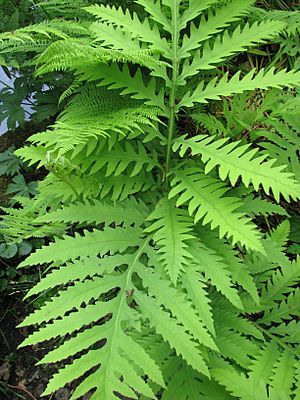Sensitive fern facts for kids
Quick facts for kids Sensitive fern |
|
|---|---|
 |
|
| Conservation status | |
| Scientific classification | |
| Genus: |
Onoclea
|
| Species: |
sensibilis
|
Onoclea sensibilis, also known as the sensitive fern or bead fern, is a type of fern that grows back every year. It loses its leaves in the fall, just like some trees. This fern gets its name because it is very sensitive to cold weather. Early American settlers noticed that its leaves would quickly die when the first frost arrived. Some people think it's the only species in its group, but others believe there are more.
Contents
What Does the Sensitive Fern Look Like?
The sensitive fern has two main types of leaves, called fronds, which look quite different.
Sterile Fronds
The fronds that don't produce spores are bright yellow-green. They are deeply cut into many parts. These fronds grow up to about 90 centimeters (35 inches) long. They have a long, smooth stem called a stipe. These fronds usually grow from a creeping underground stem called a rhizome.
Fertile Fronds
The fronds that produce spores are much smaller and are not green. They have very thin parts. The spore cases, called sori, are grouped together like beads or grapes on these upright fronds. This is why it's also called the "bead fern." When the new fronds first appear, they are curled up like a spiral and are called fiddleheads. They are a pale red color.
Where Does the Sensitive Fern Grow?
The sensitive fern is found naturally in many places. It grows in the Russian Far East, China, and other parts of Eastern Asia. It is also very common in Northern America.
Favorite Places to Grow
This fern likes to live in wet areas like swamps and woods. You can find it in wet meadows, thickets, and bogs. It also grows along stream and riverbanks, and even in ditches beside roads. In North America, it stretches from Newfoundland down to Florida and west to Texas, the Rocky Mountains, North Dakota, Quebec, and Manitoba. It has also started growing in western Europe, even though it's not originally from there.
Growing Conditions
The sensitive fern grows best in shady or partly shady spots with moist soil. It can handle drier soil if it's in the shade. It also does well in very wet soil, even at the edge of water, whether it's in sun or shade. These ferns can spread out and form large groups. They are often the first plants to grow in areas that have been disturbed. If they are not planted in the right spot, they can spread a lot and become like weeds.
How People Use the Sensitive Fern
People often grow Onoclea sensibilis in their gardens because it is a beautiful plant. It is used in regular gardens and in gardens that feature plants native to the area. It's also used in projects to restore natural habitats.
Caring for Sensitive Ferns
If you plant sensitive ferns in the shade, they can handle drier soil. But if they are in full sun, they need the soil to be very wet. To help them survive the winter, it's a good idea to leave their dried fronds on the plant until spring.
Images for kids
See also
 In Spanish: Onoclea sensibilis para niños
In Spanish: Onoclea sensibilis para niños






